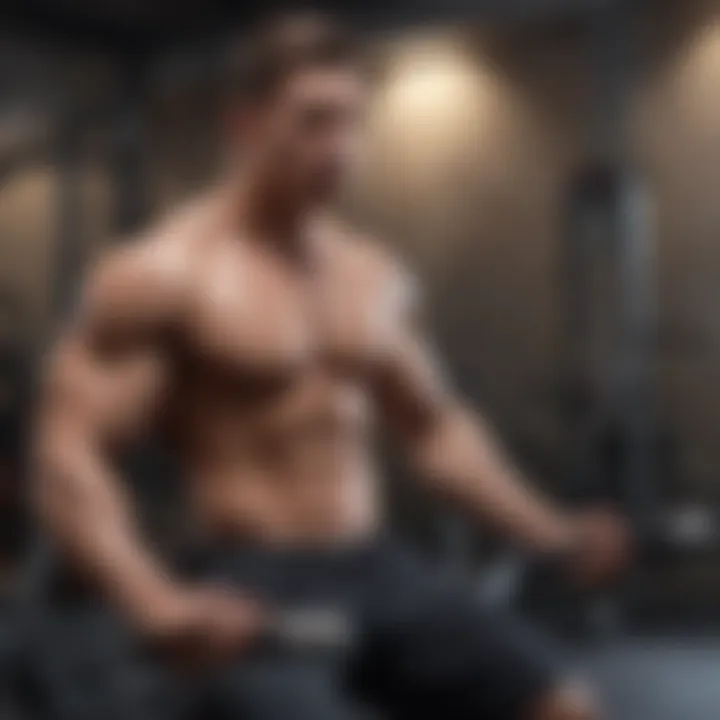Home Workout Chest Exercises: A Comprehensive Guide


Intro
Engaging in chest exercises at home serves as an effective method for enhancing upper body strength. This guide focuses on various exercises that do not require any weights or specialized equipment. It aims to equip the reader with knowledge on how to properly execute these movements. Individualizing workouts is vital to maximize benefits while minimizing injury risk.
Key Benefits
Physical Health Benefits
Home workout chest exercises have a multitude of physical benefits. First, they build muscle mass in the chest area, which is essential for overall upper body strength. Enhanced chest strength contributes to better performance in daily activities, such as lifting items or pushing against resistance.
Moreover, engaging in chest workouts stimulates the body’s metabolism. This increase helps in burning calories, aiding in weight management or loss. It also improves cardiovascular health by promoting better blood circulation and overall endurance.
In addition, exercising regularly can help improve posture. Strong chest muscles support the spine and shoulders, potentially leading to fewer injuries and discomfort associated with poor posture.
Mental Well-being Enhancements
The advantages of home workout chest exercises extend beyond physical health. Regular exercise has been shown to enhance mental well-being. It can reduce symptoms of anxiety and depression through the release of endorphins, commonly known as "feel-good" hormones.
Furthermore, achieving fitness goals can foster a sense of accomplishment and boost self-esteem. Home workouts also offer flexibility, allowing individuals to exercise at times convenient for them, promoting a sense of control and balance in their schedules.
Regular engagement in physical activity can yield significant improvements in mental health, creating a holistic approach to wellness.
Practical Tips
Effective Meal Planning
Nutrition plays a key role in muscle development and overall fitness. It’s vital to focus on a balanced diet rich in protein, healthy fats, and complex carbohydrates. Foods such as chicken, lentils, quinoa, and leafy greens provide essential nutrients needed for muscle recovery and growth.
Here are a few meal planning tips to consider:
- Organize Meals: Plan meals ahead of time to ensure you have nutritious options readily available.
- Monitor Portions: Be mindful of portion sizes to prevent overeating and maintain energy levels.
- Stay Hydrated: Proper hydration aids in muscle function and recovery, making it essential during workouts.
Quick and Efficient Workouts
Time constraints should not hinder a robust workout regime. Efficient workouts can be achieved with limited time allocation, such as 20-30 minutes.
Consider incorporating supersets, where two exercises are performed back-to-back with minimal rest. For example, alternating between push-ups and tricep dips can intensify the workout while engaging different muscle groups effectively.
In summary, dedicating time to home workout chest exercises can yield substantial benefits for both physical and mental health. By prioritizing exercise, mindful eating, and efficient workout strategies, individuals can achieve their fitness goals even in the confines of their homes.
Foreword to Home Workout Chest Exercises
In recent years, the popularity of home workout chest exercises has surged. The rise of remote work and increased focus on personal health has pushed many individuals to explore ways to stay fit in the convenience of their homes. Chest workouts particularly gain attention due to their essential role in strengthening upper body muscles. Strong chest muscles contribute not only to physical appearance but also play a vital part in overall functional strength.
Importance of Chest Workouts
Chest workouts are often overlooked in favor of training other muscle groups such as legs or abs. However, dedicating time to develop chest muscles is crucial for several reasons. Firstly, a strong chest supports daily activities that require pushing or lifting. Functional strength is built through consistent chest training, affecting overall fitness levels. Secondly, engaging in chest exercises can prevent muscle imbalances. Neglecting these muscles might lead to postural issues or an increased risk of injury. Additionally, chest workouts enhance metabolic rate, promoting better calorie burning and weight management. Through effective chest exercises, we promote aesthetic goals by increasing muscle definition, achieving a more toned appearance.
Advantages of Working Out at Home
The trend of working out at home comes with myriad benefits. Foremost, it removes barriers such as commute time to a gym, allowing individuals to integrate fitness into their daily routines easily. Home workouts are highly adaptable, offering various methods to tailor exercises based on one’s goals and available space. This flexibility can lead to a more personalized workout experience.
Moreover, home workouts typically require less financial investment than gym memberships. Many effective chest exercises can be done without equipment or with minimal gear like resistance bands or dumbbells. This accessibility invites a broader audience, fostering a more inclusive fitness culture.
Understanding Chest Anatomy
Understanding the anatomy of the chest is crucial for optimizing your home workout routine. Knowing the muscle groups involved and their functions helps in targeting them effectively. It allows fitness enthusiasts and trainers to create more focused and efficient exercise plans. This understanding also assists in preventing injuries that can arise from incorrect exercise techniques.
Muscle Groups Involved
The chest, primarily known for the pectoral muscles, comprises several key groups:
- Pectoralis Major: This is the larger muscle located at the front of the chest. Its primary function involves arm movements such as pushing and lifting.
- Pectoralis Minor: A smaller muscle lying beneath the pectoralis major, this muscle supports the movement of the shoulder.
- Serratus Anterior: Though primarily located on the side of the rib cage, this muscle plays a role in stabilizing the shoulder blade and is active during pushing movements.
Each of these muscles contributes to not only the aesthetic aspect of the upper body but also to functional strength necessary for various daily tasks and physical activities.
Function of the Chest Muscles
The chest muscles serve several vital functions:
- Pushing Movements: The pectoralis major is engaged during any pushing action, such as when performing a push-up or chest press.
- Shoulder Movement: The chest muscles are crucial for both flexing and adducting the arm, key for exercises that elevate the arm or bring it towards the body.
- Stabilization: Properly conditioned chest muscles help stabilize the upper body, thus enhancing overall athletic performance and daily functional activities.


Proper strength training of the chest can lead to improved posture and reduction in shoulder injuries.
In summary, grasping the anatomy of the chest empowers individuals to engage effectively with their workout. This knowledge not only helps in shaping a strong physique but also guides one towards safer exercise practices.
Essential Equipment for Home Workouts
When it comes to maximizing chest workouts at home, having the right essential equipment can significantly enhance your training experience. The correct equipment aids in developing strength, improving form, and increasing workout variety. Moreover, it allows individuals to tailor their routines based on personal capabilities and preferences. The following sections will explore options that can help you optimize your chest workouts without the need for a gym.
Bodyweight Exercises: No Equipment Needed
One of the standout features of home workouts is the ability to utilize bodyweight exercises. These exercises do not require any equipment and are highly effective for building chest strength. With variations such as push-ups, dips, and planks, individuals can engage their chest muscles effectively. Bodyweight exercises suit all fitness levels, making them accessible.
They also promote functional strength while enhancing body control and coordination. Adopting a routine centered on bodyweight exercises can foster muscle endurance and stability. Importantly, practitioners can execute these exercises anywhere, turning any space into a training ground.
Optional Equipment for Enhanced Workouts
While bodyweight exercises are highly effective, incorporating optional equipment can further enhance your workouts. This allows for more diverse routines and targeting of specific muscle groups more effectively. Here’s a closer look at three types of equipment that can enrich your home chest workout experience.
Resistance Bands
Resistance bands are a prominent choice for home workouts. They are versatile, portable, and provide the ability to perform a wide range of exercises that target the chest and other muscle groups. One key characteristic of resistance bands is their variable resistance. As you stretch the bands, it becomes harder, which maximizes muscle engagement throughout the movement.
The unique feature of resistance bands is their ability to simulate various exercise modalities, such as presses and flies, which are essential for thorough chest training. Their lightweight and compact nature make them a popular option for home exercisers. However, users must ensure they choose the correct resistance level to prevent injury and maximize effectiveness.
Dumbbells
Dumbbells are another essential piece of equipment for home workouts. Their key characteristic is versatility, allowing users to perform unilateral or bilateral exercises easily. Dumbbells can target specific muscles more effectively compared to bodyweight exercises alone. They enable a range of movements, including presses, flyes, and pullover exercises, all critical for chest development.
A unique advantage of dumbbells is that they require stabilization from the muscles, which improves overall strength and control. However, they do necessitate a certain level of initial investment, and safety must be a consideration when performing heavy lifts, especially at home without a spotter.
Weighted Vests
Weighted vests are advantageous for users who have progressed beyond basic bodyweight exercises. The concept is simple—by adding weight to your body, you increase the intensity of your workouts. This equipment is especially effective for standard push-ups, dips, and even dynamic movements.
A standout characteristic of weighted vests is their adjustable weight distribution. This allows individuals to modify the load based on their strength and training goals. However, while they can substantially increase workout intensity, care must be taken to avoid strain, especially on lower back and shoulder joints. Users should gradually integrate weighted vests into their routine, ensuring proper form is maintained at all times.
Incorporating such equipment into your home workouts can significantly elevate the effectiveness and enjoyment of your training regimen. By understanding how each element contributes to your workout goals, you can craft a balanced and efficient routine.
Fundamental Bodyweight Chest Exercises
Fundamental bodyweight chest exercises are integral to any home workout routine. These exercises utilize the body’s own weight, offering an accessible and efficient means to strengthen the chest muscles. They can be performed anywhere, requiring no additional equipment, and provide a robust foundation for upper body strength development.
Performing bodyweight exercises helps in building muscular endurance, strength, and stability. They engage not only the chest muscles but also the shoulders, triceps, and core, making them holistic in nature. Regular practice enhances functional strength, which can benefit daily activities and other forms of physical training.
Push-Ups: Variations and Techniques
Push-ups represent the cornerstone of bodyweight chest exercises and come in various forms to target different muscle groups.
Standard Push-Ups
Standard push-ups are a foundational exercise that highlights proper form while effectively engaging the pectoral muscles. This exercise requires no equipment, making it highly accessible. The key characteristic of standard push-ups is their ability to strengthen the entire upper body, focusing on the chest, triceps, and shoulders.
The unique feature of standard push-ups lies in their versatility. They can be easily modified for varying fitness levels simply by adjusting the hand placement or body angle. The advantages of standard push-ups include improved core stability as well as muscle strength gain. However, improper form can lead to strain, thus paying attention to the technique is crucial.
Wide Grip Push-Ups
Wide grip push-ups expand the hand placement beyond shoulder-width, targeting the outer portion of the chest. This variation alters the emphasis of the standard push-up, drawing more activation from the chest muscles instead of the triceps. They are popular among those looking to sculpt a wider chest.
The distinct feature of wide grip push-ups is how they isolate the chest muscles. The advantages of this variation include heightened activation of the pectorals. However, they may not be suitable for beginners, as the wider stance can make the movement more challenging.
Diamond Push-Ups
Diamond push-ups are an advanced variant where the hands are positioned close together, forming a diamond shape. This setup shifts the focus towards the inner chest and triceps. This exercise is highly effective for building muscle definition in the upper body.
The key characteristic of diamond push-ups is their increased difficulty. They require greater wrist and shoulder strength, making them more challenging than standard push-ups. The advantage of performing this exercise is enhanced triceps development alongside inner chest activation, which offers a balanced upper body workout. However, those new to push-ups may struggle with this variation due to required strength and balance.
Dips: Effective Options for Home
Dips are another powerful bodyweight exercise that targets the chest, triceps, and shoulders. They can be performed using parallel bars or a sturdy surface like a chair or a low table. The motion involves a downward movement followed by an upward push, which effectively engages the upper body.
One effective option for performing dips at home is using two chairs. Placing one hand on each chair enables a solid dip workout while maintaining stability. Dips promote chest muscle activation and can contribute significantly to upper body strength when included in a workout routine.
Incline and Decline Push-Ups


Incline push-ups are performed with hands elevated on a platform. This variation decreases the load on the chest, making it suitable for beginners. Conversely, decline push-ups involve placing the feet on an elevated surface, which increases resistance on the chest. Both variations allow a stimulus change, enabling muscle growth and strength progression.
Incorporating incline and decline push-ups in a routine adds variety and targets different areas of the chest. Both exercises can be easily adjusted for all fitness levels, making them ideal for anyone looking to enhance their strength effectively.
Incorporating Resistance Bands in Chest Workouts
Resistance bands offer a versatile and effective way to enhance home workouts, especially for chest exercise. Their flexibility and simplicity make them a great addition to any workout regimen. Resistance bands can be used to perform a variety of chest exercises that engage the pectoral muscles without the need for extensive equipment or large weights. This aspect is particularly useful in a home setting, where space and budget can be constraints.
One major benefit of using resistance bands is their capacity to provide variable resistance throughout the movement. Unlike traditional weights, which exert uniform force, bands create increasing resistance as they stretch. This means your muscles face more challenge as they progress through the range of motion, which can lead to greater strength gains and hypertrophy. Moreover, resistance bands are portable, thus allowing for workouts to be done anytime and anywhere.
It’s important to consider the correct band thickness when selecting for chest exercises. Thicker bands provide more resistance, but they may also compromise form if the user does not have sufficient strength to control the movement. Having a variety of bands can cater to different strength levels and exercise styles, allowing for progressive resistance training. Additionally, they can help in accessing a broader range of motion, which is essential for chest exercises as it promotes better muscle engagement and activation.
As resistance bands can be anchored to a fixed point, they allow for unique angles of chest exercises that may not be easily accessible with weights alone. This versatility helps target different parts of the chest more effectively. When integrating resistance bands into a workout routine, it is critical to maintain proper form to prevent injury and ensure effective muscle engagement.
A few key points to keep in mind while using resistance bands for chest workouts:
- Choose the right band thickness for your comfort and strength level.
- Focus on form and control throughout each exercise to maximize effectiveness.
- Incorporate various angles to target different areas of the chest muscles.
Resistance bands not only provide a versatile way to engage the chest muscles but also promote safety and effectiveness in home workouts.
Chest Press with Resistance Bands
The chest press using resistance bands mimics the motion of a traditional dumbbell or barbell press, but with the advantages of bands mentioned earlier. To perform this exercise, anchor the band securely at chest height and hold the ends of the band in each hand. Begin with your elbows bent and the bands taut, then push forward until your arms are fully extended.
Make sure to keep a controlled movement as you bring your hands back to the starting position. It is essential to avoid letting the bands snap back too quickly to maintain tension on the muscles being worked. Focusing on a full range of motion will engage the pectorals optimally. You can adjust the difficulty by using bands of different thickness or changing your distance from the anchor point.
Seated Chest Fly with Resistance Bands
The seated chest fly is another effective exercise that can be performed with resistance bands, targeting the outer pectoral muscles. To execute this exercise, sit on the floor or a sturdy chair with your back straight. Anchor the band behind you at a low height. With a secure grip on the bands, extend your arms out to the side at shoulder level. Bring your hands toward each other in a controlled manner, as if you are hugging a large tree.
This movement should be slow and deliberate, focusing on squeezing your chest at the midpoint of the motion. After reaching the center, return to the starting position to complete one repetition. Adjust the tension by altering the distance from the anchor or using a thicker band. Utilizing this exercise regularly will help to build and define the chest muscles effectively.
Utilizing Dumbbells for Comprehensive Chest Workouts
Dumbbells are a versatile piece of equipment that plays a significant role in home workout routines. They offer a way to target the chest muscles effectively while providing benefits that align with various fitness goals. Using dumbbells can lead to improved muscle activation due to the freedom of movement they allow. This creates the potential for a greater range of motion compared to fixed gym machines. The nature of dumbbell exercises promotes balance and coordination, engaging stabilizing muscles in the process.
When incorporating dumbbells into your chest workout, it is crucial to select the appropriate weight. It should challenge your muscles without compromising form. Proper form is essential, as good technique minimizes the risk of injury and maximizes effectiveness. As you become comfortable with a specific weight, gradually increasing resistance will ensure continuous muscle adaptation and growth.
In summary, utilizing dumbbells for chest workouts allows for flexibility and adaptability, which are key for muscle development in a home setting.
Dumbbell Chest Press
The dumbbell chest press is a fundamental exercise for building chest strength. It can be performed on a flat bench or on the floor. Lying back with dumbbells in each hand, arms extended above the chest, you lower the weights until your elbows are at about a 90-degree angle. This movement mirrors the barbell bench press but offers a unique advantage by individually engaging each arm.
Benefits of the Dumbbell Chest Press:
- Enhances chest muscle activation.
- Improves stabilizer muscle engagement.
- Allows for a more natural movement path compared to fixed machines.
When performing this exercise, focus on controlled movements. Avoid arching your back or using momentum to lift the weights. Start with a moderate weight and gradually increase as strength improves.
Dumbbell Flyes
Dumbbell flyes are excellent for isolating the chest muscles and improving muscle width. To perform this exercise, lie on a flat bench, holding a dumbbell in each hand above your chest. While keeping a slight bend in your elbows, lower the weights to the sides in a controlled motion until you feel a slight stretch in your chest. Then, raise the weights back to the starting position.
Benefits of Dumbbell Flyes:
- Targets the pectoral muscles, emphasizing the outer chest.
- Enhances flexibility and stretch in the chest area.
- Can be adapted to different angles, like incline or decline, to target various parts of the chest.
As with any exercise, ensure that you maintain proper form. Use a weight that allows you to perform a set number of reps without compromising technique.
Incorporating dumbbell exercises such as the dumbbell chest press and flyes into your routine can significantly enhance your overall chest development. They provide a safe and effective way to build strength while being adaptable to different fitness levels.
Designing a Balanced Chest Workout Routine
Creating a structured chest workout routine is essential for obtaining optimal results. A well-rounded program ensures development of all areas of the chest muscles while minimizing the risk of injury. It also helps maintain motivation by introducing variety in workout. Balance is a key component to achieve both strength and aesthetic goals in home workouts.
When designing a routine, consider the frequency and duration of workouts. These elements will help set a clear pathway for progress, ensuring that muscles are effectively worked without fatigue. Giving consideration to recovery time is also important, as muscles need rest to rebuild and grow.
Frequency and Duration of Workouts
Frequency refers to how often you engage in chest workouts within a given timeframe. Most fitness experts recommend training the chest twice a week. This allows for adequate muscle stimulation without leading to burnout from excessive workouts. The duration of each workout can vary but typically falls between 30 to 60 minutes. Keeping sessions focused and efficient helps in maintaining intensity and engagement.
Incorporating different exercises within each session can enhance effectiveness. For instance, one day could focus on push-up variations, while another day could integrate dumbbell exercises. Alternating between different types of exercises hits various muscle groups and can lead to better overall strength.


Sample Weekly Workout Plan
A sample weekly workout plan can provide structure and consistency to your training routine. Here’s a simple outline:
- Monday:
- Wednesday:
- Friday:
- Standard Push-Ups: 3 sets of 10-15 reps
- Incline Push-Ups: 3 sets of 8-12 reps
- Dips: 3 sets of 8-10 reps
- Dumbbell Chest Press: 3 sets of 10-15 reps
- Dumbbell Flyes: 3 sets of 10-12 reps
- Resistance Band Chest Press: 3 sets of 10-15 reps
- Wide Grip Push-Ups: 3 sets of 8-12 reps
- Decline Push-Ups: 3 sets of 8-10 reps
- Seated Chest Fly with Bands: 3 sets of 10-15 reps
This plan covers various exercises targeting the chest muscles. Feel free to modify the number of sets and repetitions based on your own fitness level and goals. Additionally, rest days are crucial for recovery and performance. Incorporate light activities or rest between workout days.
Common Mistakes to Avoid in Chest Workouts
Performing chest exercises at home offers numerous advantages, but it also comes with potential pitfalls. Understanding common mistakes can enhance your workout effectiveness and prevent injuries. This section delves into two key mistakes: poor form and neglecting recovery.
Poor Form and Technique
The significance of maintaining proper form cannot be overstated. Poor form during chest exercises can lead to ineffective workouts and, more critically, injuries. When the technique is compromised, even the best-designed routine can fail to deliver results. For example, during push-ups, allowing the hips to sag or the elbows to flare out can strain the shoulders and back.
To avoid this mistake, focus on:
- Alignment: Keep your body straight from head to heels. This ensures that the right muscles are engaged throughout the movement.
- Controlled Movements: Avoid hastiness. Perform each rep with control to maximize muscle tension and engagement.
- Mind-Muscle Connection: Be aware of the muscles you are targeting. Concentrating on the chest during movements will yield better results than mindlessly pushing through the reps.
In your workout regimen, consider documenting your form through video analysis or with the help of a peer. This can provide insight into aspects of your technique needing adjustment.
Neglecting Muscle Recovery
Another critical error in home chest workouts is neglecting recovery time. Muscle recovery is vital for strength growth and overall performance. When workouts are consistent but recovery is ignored, muscles do not have adequate time to repair, potentially leading to fatigue and overtraining.
To prevent this mistake, emphasize:
- Rest Days: Schedule specific days for rest. Ensuring you have 48 hours between intense chest workouts allows the muscles to repair.
- Active Recovery: Engage in low-intensity activities, such as walking or yoga, on rest days. This helps maintain blood flow and facilitates recovery without adding excessive strain.
- Nutrition and Hydration: Proper diet supports muscle repair. Include proteins, healthy fats, and carbohydrates in your post-workout meals.
"Recovery is just as important as the workout itself. A well-recovered muscle performs better and grows more effectively."
In summary, avoiding poor form and incorporating sufficient recovery strategies can substantially improve your home chest workout experience. Focus on technique and listen to your body to see progress.
Tracking Progress and Adaptation
Tracking progress and adaptation is vital for anyone serious about building strength through home chest workouts. It allows individuals to assess their improvements and make necessary modifications to their routines. Notably, the key aspects include establishing a baseline, monitoring strength gains, and recognizing when to incorporate new exercises or increase resistance. These factors significantly influence motivation and accountability.
Setting Achievable Goals
Setting achievable goals is the first step in tracking progress effectively. Goals should be specific, measurable, attainable, relevant, and time-bound. Rather than vague aspirations like "get stronger," individuals should aim for more concrete targets, such as "perform 10 push-ups without stopping within four weeks." This kind of clarity makes it easier to focus efforts and observe improvements.
When individuals reach their goals, it encourages them to push further and set new ones. It helps avoid plateaus, which can dampen motivation. Keeping a journal to note achievements, such as the number of reps or time taken for exercises, serves as a tangible method to visualize progress.
Adjusting Workouts Based on Progress
Adjusting workouts based on progress ensures continual growth and development in chest strength. Regular assessments allow practitioners to determine if they are still challenged or if they have plateaued. For instance, if someone can easily perform 15 push-ups, it may be time to try a more difficult variation, such as decline push-ups.
Additionally, increasing the intensity of exercises can be done by shortening rest intervals or increasing the volume and frequency of workouts. For example, if you normally do three sets of ten, consider adding an extra set or increasing to twelve repetitions.
Overall, adaptive strategies that respond to individual progress are crucial. They prevent boredom and provide fresh challenges, which can lead to enhanced performance and improved physical outcomes.
"Tracking allows you to take full control of your home fitness journey."
In summary, monitoring progress and adapting workouts is essential for anyone wishing to maximize their home chest strength training. With clearly defined goals and a responsive approach to exercise design, individuals can enjoy ongoing achievement and keep challenges alive.
Ending: Building Chest Strength at Home
Building chest strength at home offers numerous benefits that extend beyond mere aesthetics. In this guide, we have explored various home workout chest exercises and understand their significance. The chest muscles, primarily composed of the pectoral group, play an essential role in upper body strength and overall functional fitness. By effectively engaging these muscles, individuals can enhance their physical capabilities, support daily activities, and improve overall body coordination.
Importance of Consistent Training
Consistency is crucial in building muscle strength. Home workouts allow for flexible scheduling, enabling individuals to prioritize their fitness goals in a way that fits their daily routines. Regular training can lead to noticeable strength gain over time. Exercises such as push-ups, dips, and various dumbbell routines require little or no equipment, making them accessible to anyone, regardless of their location.
Adapting to Individual Needs
The versatility of home workouts is another notable advantage. Individuals can adjust their routines based on their experience level and progress. For beginners, mastering basic push-up forms is essential before advancing to more challenging variations. This adaptability ensures that every participant can engage with the exercises at a comfortable intensity, reducing the risk of injury.
Enhancing Mental and Physical Well-being
Beyond physical strength, engaging in rigorous chest workouts contributes positively to mental health. Regular exercise releases endorphins, which are hormones that contribute to feelings of happiness and relaxation. This holistic approach—that integrates both body and mind—improves overall well-being.
"A strong chest improves not just physical performance, but also mental acuity and resilience."















